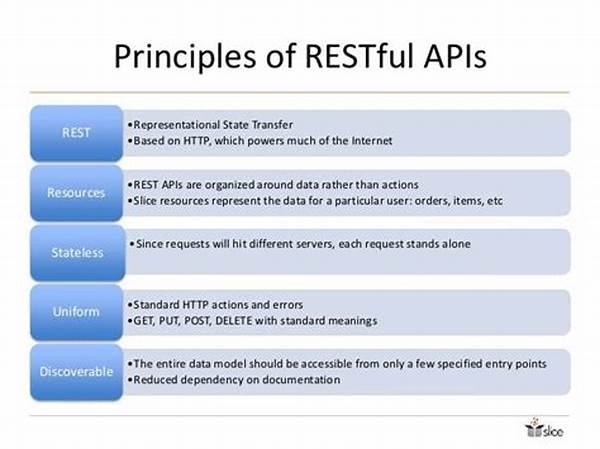In the contemporary digital landscape, the significance of RESTful API design principles cannot be overstated. As the cornerstone of modern web development, these principles underpin the creation of interfaces that are both scalable and maintainable, facilitating seamless interaction between disparate software systems. An understanding of RESTful APIs is indispensable for software developers striving to enable efficient data communication across various platforms. These principles guide developers in designing APIs that adhere to the constraints of REST architecture, a paradigm that emphasizes statelessness, client-server separation, and a uniform interface among others.
Read Now : Data-based Evaluation Of Journal Standards
Key Components of RESTful API Design
The key components of RESTful API design principles provide a structured framework for developing robust APIs. At its core, REST (Representational State Transfer) is an architectural style that prescribes a set of constraints for creating scalable web services. RESTful APIs leverage HTTP protocols for communication, utilizing standard operations such as GET, POST, PUT, and DELETE to perform different CRUD (Create, Read, Update, Delete) actions. These principles ensure that APIs effectively handle web-based interactions, enhance flexibility, and promote performance optimization. By adhering to RESTful API design principles, developers can create interfaces that are intuitive for users and straightforward to interact with, thereby ensuring consistent and reliable software interaction.
Implementing RESTful API Design Principles
1. Statelessness: RESTful API design principles emphasize statelessness, where each request is independent and contains all necessary information. This simplifies the interaction between client and server.
2. Resource Identification: These principles advocate for clear resource identification via URIs, making APIs easier to use and manage, as well as facilitating predictable resource access and manipulation.
3. Client-Server Architecture: By promoting a separation of concerns, these principles enhance scalability and flexibility, allowing clients and servers to evolve independently.
4. Cacheability: RESTful API design principles stress the importance of cacheability to improve performance, enabling responses to be cached and reused to reduce latency and load.
5. Uniform Interface: This principle ensures that the overall system architecture is simplified by maintaining a consistent, standardized communication interface between components.
Designing Effective RESTful APIs
Designing effective RESTful APIs necessitates a comprehensive understanding of RESTful API design principles. These principles offer a paradigm for structuring APIs that support scalability, reliability, and performance across distributed networks. By adhering to established guidelines such as statelessness, cacheability, and uniformity, developers can create intuitive and maintainable systems. Prioritizing client-server decoupling allows for better modularity, facilitating independent evolution of clients and servers without compromise. Moreover, utilizing hypermedia as the engine of application state (HATEOAS) further enriches the API by dynamically guiding user interaction through links embedded in responses. The implementation of RESTful API design principles ultimately leads to improved software systems that effectively meet user needs while remaining adaptable to emerging technological trends.
Challenges in RESTful API Design
The implementation of RESTful API design principles, while beneficial, is not free from challenges. API designers must contend with striking a balance between flexibility and simplicity. Ensuring uniformity without overcomplicating resource access or degrading user experience is paramount. Furthermore, the stateless nature of RESTful APIs introduces complexities such as managing authentication and session state without compromising security. Developers must be vigilant in maintaining backward compatibility, allowing existing clients to function seamlessly with evolving APIs. As RESTful principles are underscored by a focus on HTTP status codes, developers are tasked with effectively using these codes to convey meaningful error messages and responses. Overcoming these challenges requires meticulous planning, iterative testing, and an unwavering commitment to designing foundational and scalable APIs.
Best Practices for RESTful API Implementation
1. Use clear and consistent naming conventions to ensure intuitive access to resources.
2. Implement versioning to maintain compatibility and manage API evolution effectively.
3. Employ comprehensive documentation to facilitate developer understanding and usage.
Read Now : Impact Metrics In Academia
4. Utilize HTTP status codes creatively to convey the appropriate meaning and intent of API interactions.
5. Adhere to security best practices, ensuring robust authentication and authorization mechanisms are in place.
6. Design with scalability in mind, enabling the API to handle increased loads gracefully.
7. Implement pagination and filtering to limit the resources returned in responses.
8. Encourage input validation and error handling to mitigate potential faults.
9. Leverage HATEOAS to contextualize responses and guide users in navigating the API.
10. Emphasize idempotency in operations to maintain predictable and reliable interaction.
Addressing Common RESTful API Design Pitfalls
In applying RESTful API design principles, developers often encounter common pitfalls that can undermine API effectiveness. One major challenge involves designing overly complex APIs that hinder usability. To prevent this, simplicity should remain a guiding ethos, ensuring ease of understanding and use. Another pitfall is neglecting proper authentication and authorization, exposing APIs to security vulnerabilities. Developing a robust security architecture that encompasses comprehensive user authentication and authorization mechanisms is essential. Additionally, inadequate error handling can lead to ambiguous user experiences; thus, crafting meaningful and informative error messages is crucial. Overcoming these pitfalls demands a strategic approach, involving rigorous testing and continuous enhancement of the API to align with evolving user needs, while strictly adhering to RESTful API design principles.
Achieving High-Quality RESTful API Design
High-quality RESTful API design is grounded in the assiduous application of RESTful API design principles, harmonizing functionality with usability. This pursuit entails meticulous attention to naming conventions, ensuring resources are clearly and consistently represented through intuitive URI structures. Consistent implementation of these principles instills robustness, facilitating reliable API interaction and navigation. Moreover, employing industry-standard security practices safeguards sensitive information against potential threats, while comprehensive documentation empowers developers with the requisite knowledge to effectively leverage the API’s capabilities. A commitment to continuous testing, monitoring, and iterating on API performance further contributes to sustained quality and reliability. By integrating these elements within the cohesive framework of RESTful API design principles, developers can create interfaces that are not only responsive and efficient but also capable of evolving alongside technological advancements and user expectations.
